Electric Eel
Electrophorus Electricus
Despite its powerful shock, electric eels have terrible vision.
Advertisement
Electric Eel Scientific Classification
- Kingdom
- Animalia
- Phylum
- Chordata
- Class
- Actinopterygii
- Order
- Gymnotiformes
- Family
- Gymnotidae
- Genus
- Electrophorus
- Scientific Name
- Electrophorus Electricus
Read our Complete Guide to Classification of Animals.
Electric Eel Conservation Status
Electric Eel Facts
- Prey
- Fish, insects, small vertebrates, crustaceans
- Fun Fact
- Despite its powerful shock, electric eels have terrible vision.
- Estimated Population Size
- Unknown
- Biggest Threat
- Humans
- Most Distinctive Feature
- Slimy mucus with three organs to generate current.
- Other Name(s)
- Arimna (Venezuela), “numb eel” (Europe)
- Gestation Period
- Unknown
View all of the Electric Eel images!
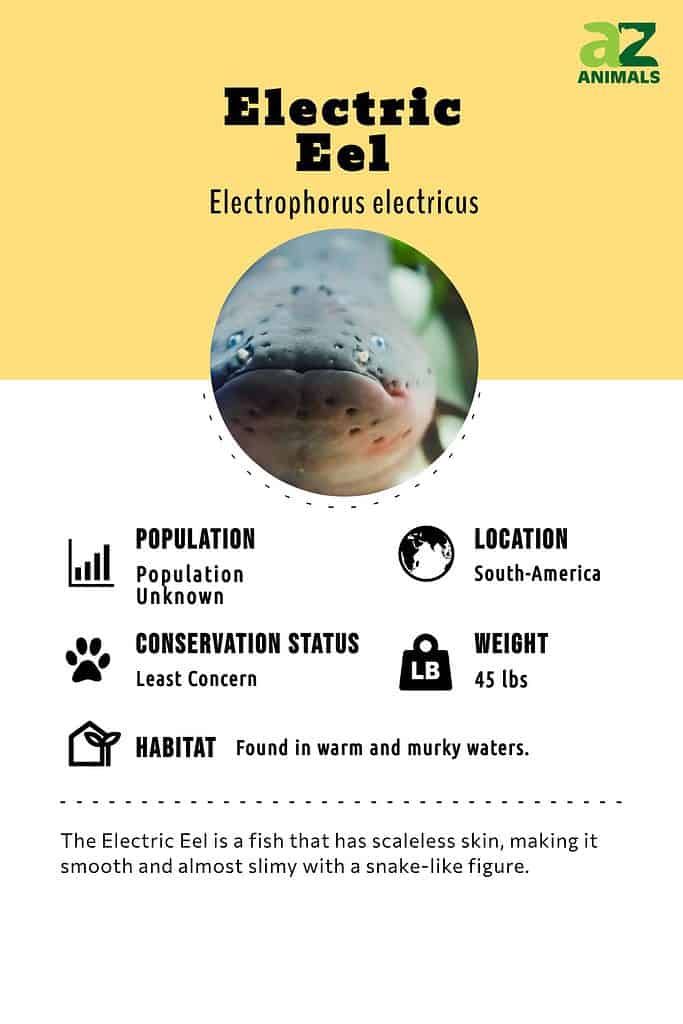
“For 250 years, scientists thought the electric eel was a singular species and completely alone in its genus.”
Known as the “numb fish” in some parts of the world, the electric eel isn’t a true eel. This freshwater fish resides predominantly in the Amazon, even though the larvae float to New Zealand as they hatch. The bony body of the fish keeps it from offering much meat in eclectic dishes, but their exclusivity creates high demand.
Along the bottom of its body, the eel has multiple organs to set off each electric shock when they need to attack in the water.
5 Incredible Electric Eel Facts!
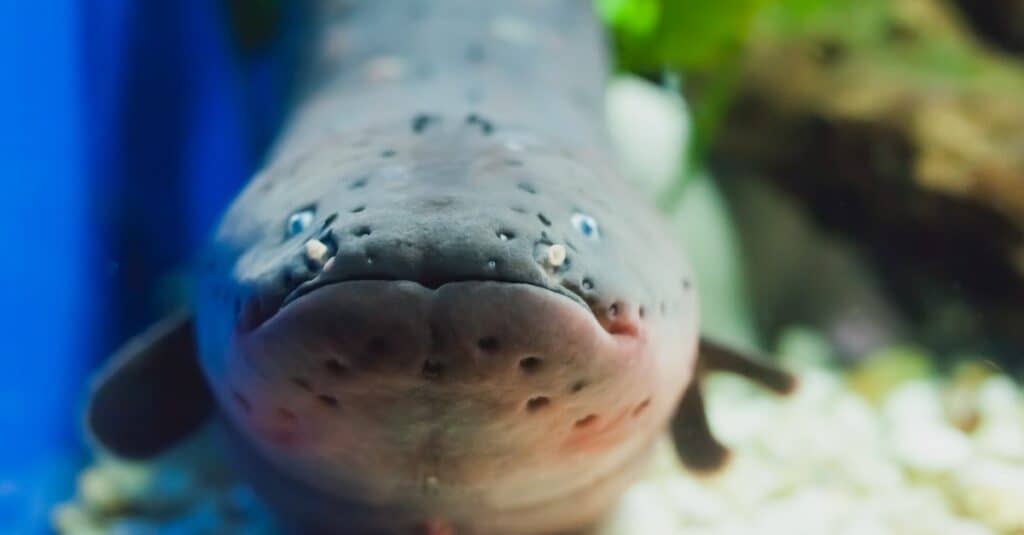
Electric Eels have horrible eyesight
©iStock.com/stacey_newman
Here are a few facts about the electric eel:
- The diet of an electric eel is carnivorous, using its shock to attack any prey.
- Their total length can be more than 8 feet long.
- They prefer areas with fresh and murky water, though the rising water levels in rivers in South America can put them at risk for attack by land mammals.
- Though most “fun facts” lists categorize the electric eel with other eels, they are closer in their genetics to carp and catfish.
- This species is nocturnal with terrible eyesight.
Classification and Scientific name

Electric eel (Electrophorus electricus), at the New England Aquarium
The scientific name of this species is Electrophorus Electricus. They are known by a few different names around the world, including “arimna” and “numb eel,” though these names are specific to Venezuela and Europe (respectively).
From the order of Gymnotiformes, the electric eel is part of the Gymnotidae family in the Actinopterygii class. Currently, there are three types of electric eels.
The scientific name is relatively straightforward in its meaning. “Electrophorus” comes from the Greek words ήλεκτρον (“electron”) and ϕέρω (“phero”), literally translating to “electricity bearer.” “Electricus” is a Latin word, which comes from the word “amber,” due to the substance that gets rubbed together to cause electrostatic energy.
Evolution and Origins
Somewhere between 100 and 200 million years ago, fish began to change. They evolved into electrolytes from muscle cells that were organized in a sequence of generating a much higher voltage.
Evolution took advantage of fish genetics to develop electric organs. All fish have duplicate versions of the sodium channel gene that produces tiny muscle switches. For electric eel to be able to evolve electric organs, electric fish turned off one duplicate of the gene in muscles.
List of Different Types of Electric Eels
There are three main species of electric eel:
- The electric eel (Electrophorus electricus)
- Vari’s electric eel (E. varii)
- Volta’s electric eel (E. voltai)
Appearance
Typically growing to a length of 8 feet or more, the electric eel varies in size until it is an adult, eventually reaching about 45 pounds. Found in warm and murky waters, this fish has scaleless skin, making it smooth and almost slimy with a snake-like figure. Their back and sides feature dark gray, which is why they hide so well in darker waters. Their belly is typically yellow to orange.
The organs that set off the electric shock – the main electrical organ, Hunter’s organ, and the Sachs’ organ – are responsible for producing 1+ amps. Each attack releases 1+ amps, which is why there are no consistent predators. After all, one or two amps alone are enough to induce a severely painful shock.
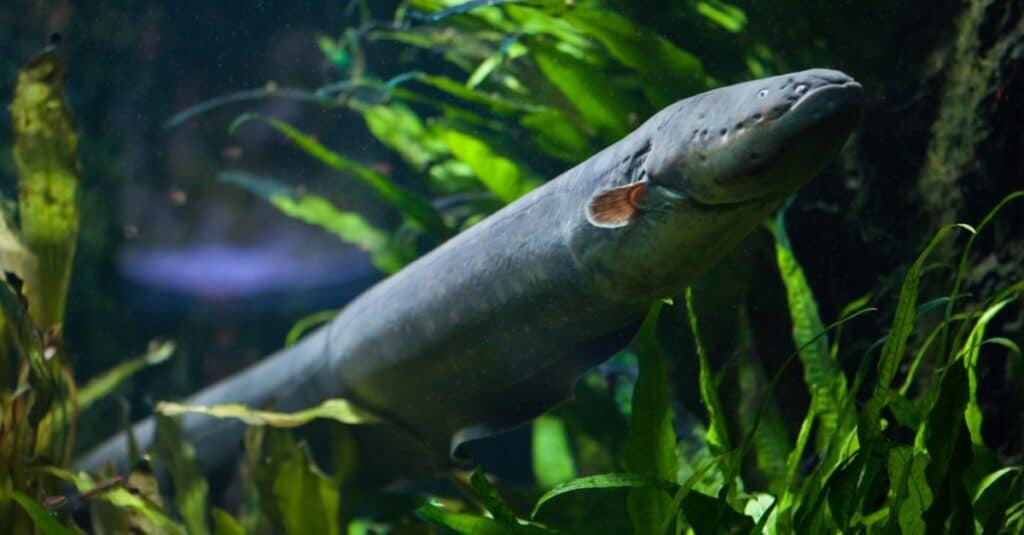
©iStock.com/wrangel
Distribution, Population, and Habitat
Where to Find Electric Eels and How to Catch Them
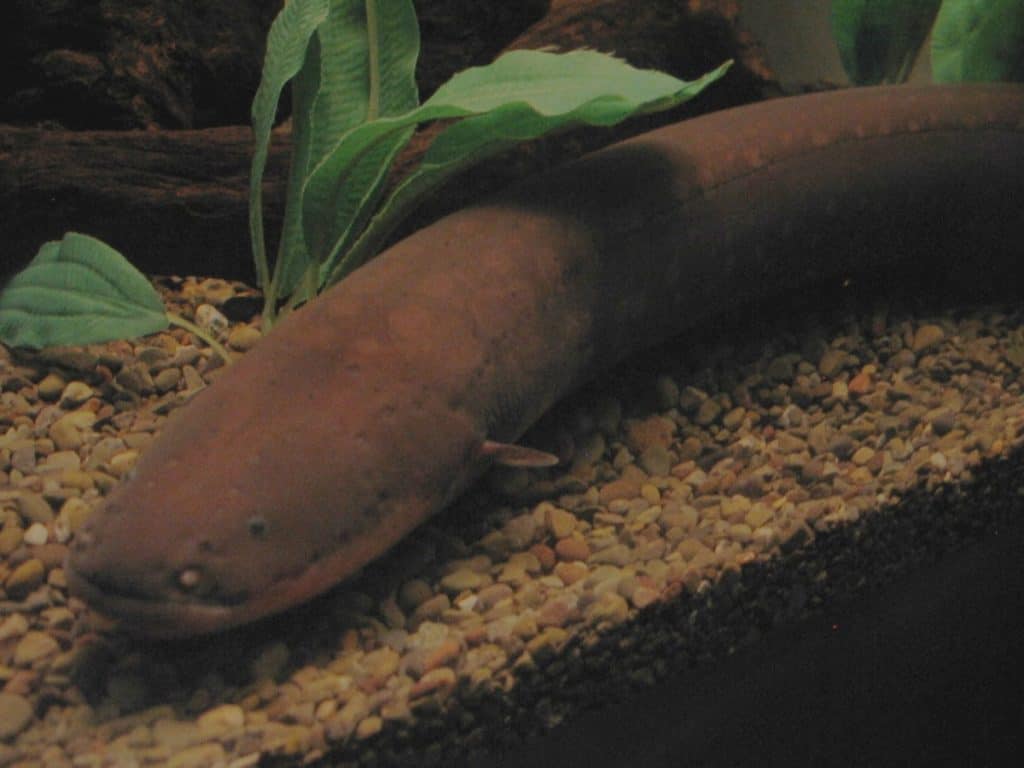
The natural habitat of the electric eel is exclusively freshwater areas
The natural habitat of the electric eel is exclusively freshwater areas, even though they prefer murky pools. These habitats are easily found in South America, though they are primarily found in the middle and lower Amazon and Orinoco river basins. Though they can live in many water depths, they reach the surface to breathe the air because of the anoxic waters.
Currently, the electric eel is not endangered, so no conservation efforts are being made. Locals are encouraged to stay away from them and not capture them to protect the area from infestations.
Predators and Prey
This species is carnivorous, going after other animals as their prey. They hunt in the waters they live in, using the electric current along the length of their underside to attack their target.
What eats electric eels?

Apart from being fished by humans, electric eels have no known predators.
©iStock.com/John Richard Stephens
Apart from being fished by humans, electric eels have no known predators. They are too dangerous for other species to go after, regardless of water levels. If the water is shallow, there’s a chance that large land mammals will go after them, but this threat is often deterred with a shock.
What do electric eels eat?
Electric eels have quite a selection available to them in South America. Their preferred diet includes amphibians, fish, and crustaceans. When they are still young, they’ll primarily indulge in crabs, shrimp, and other invertebrates.
Reproduction and Lifespan
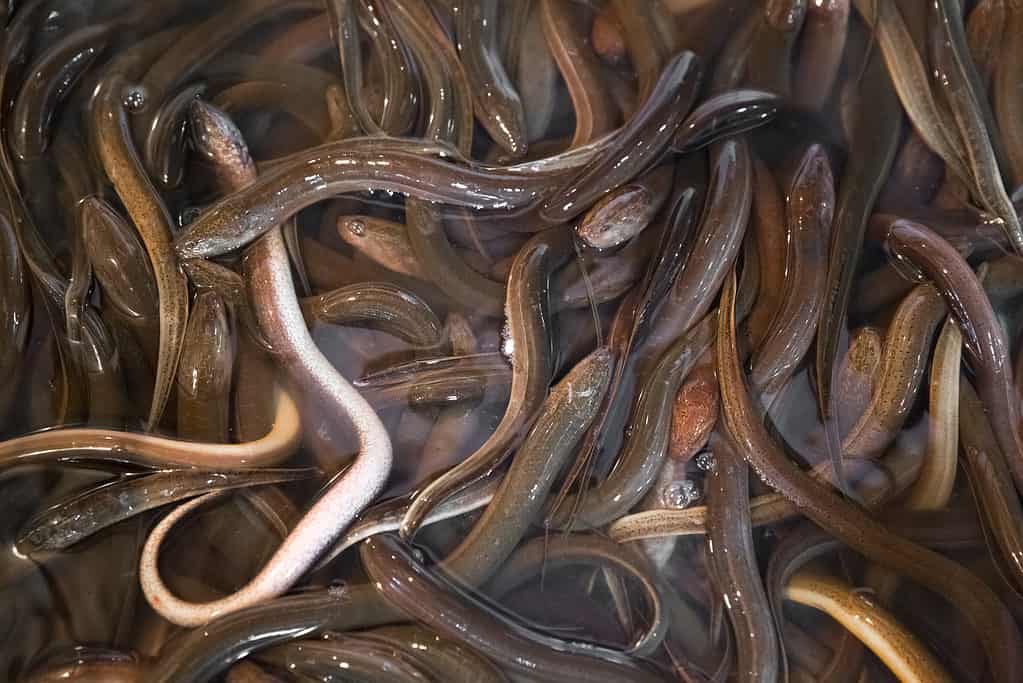
Baby eels at a fish market in China
©Valentin Ayupov/Shutterstock.com
As popular as the electric eel might be, so much of their life is still a mystery. Scientists still don’t know much about the breeding process, though males and females work together for their brood. During a dry season, the female lays her eggs in the nest made by the male. These nests are made with the saliva of the male. Males fertilize the eggs, which can add up to 1,700 each year by the female.
Once the eggs are in the nest and fertilized, the eels die. The eggs slowly hatch, floating to the surface of the water after they become larvae. The water current brings them to New Zealand and other areas, though it can take them 17 months or more to reach their destination.
The average lifespan of an electric eel is anywhere from 12 to 22 years, though females generally live longer.
Fishing and cooking

While most eels count as a delicacy that is worth the work, electric eels are much bonier.
©iStock.com/Zakharova_Natalia
Catching any type of eel is best done at sea because it means that they’ve reached their best size and fat content. Collecting electric eels can be difficult, but most anglers use equipment like baited long lines, spears, and baited traps commercially. Personal preference plays a role.
While most eels count as a delicacy that is worth the work, electric eels are much bonier. Their body featured little meat, but there are still many recipes online to show you how to sautee, bake, and cook the fish in other ways.
Population
This species tends to flourish throughout the regions they are found in, but researchers have found it difficult to determine their exact population. They are not legally allowed to be collected without a permit relating to scientific research, and locals cannot keep electric eels due to their risk to both populations of humans and fish if released.
View all 117 animals that start with EElectric Eel FAQs (Frequently Asked Questions)
How many eggs do Electric Eels lay?
Electric Eels typically lay 20,000 eggs.
What is an electric eel?
An electric eel is a freshwater fish with a long body that uses electricity to kill its prey. They also use these pulses to navigate through the water and defend themselves.
Where are electric eels found?
Most species live in murky water, though they are also found in the Amazon and Orinoco river basins. They look for areas with plenty of food, like crabs and freshwater shrimp.
How does an electric eel work?
Electricity comes from three sets of organs along the abdomen, generating a current.
Are electric eels fish?
Yes. The electric eel is a fish that only lives in freshwater areas.
Do eels really have electricity?
Only the electric eel produces electricity. However, they fall under the category of knifefish rather than being considered a true eel. Their shock can reach a voltage of 600V.
What happens if you touch an electric eel?
If the eel manages to press his chin onto you, you’ll likely receive a shock. The voltage, pain, and damage can vary.
Can you be killed by an electric eel?
While it is rare to get a shock with enough voltage to kill you, being shocked multiple times could cause respiratory or heart failure. If you’re in the water, you can even drown in shallow water.
Can an electric eel power a light bulb?
Theoretically, with a high enough voltage, yes. Since they produce between 10 and 850 volts per shock, a more considerable jolt would be enough to activate the coil in a 40-watt light bulb.
Can an electric eel power a house?
Since an electric eel simply creates a current, it is unlikely to generate enough power for a small house.
Thank you for reading! Have some feedback for us? Contact the AZ Animals editorial team.
Sources
- Smithsonian's National Zoo and Conservation Biology Institute, Available here: https://nationalzoo.si.edu/animals/electric-eel
- Kidadl, Available here: https://kidadl.com/animal-facts/electric-eel-facts
- National Aquarium, Available here: https://aqua.org/explore/animals/electric-eel
- Wikipedia, Available here: https://en.wikipedia.org/wiki/Electric_eel
- Science Focus, Available here: https://www.sciencefocus.com/nature/how-do-electric-eels-generate-voltage/
- National Geographic, Available here: https://www.nationalgeographic.com/animals/fish/facts/electric-eel
- Daily Mail, Available here: https://www.dailymail.co.uk/news/article-7755199/Shocked-Electric-eel-powers-aquariums-Christmas-lights.html
- FAO, Available here: https://www.fao.org/3/x5915e/x5915e01.htm
- Wikipedia, Available here: https://en.wikipedia.org/wiki/Electrophorus

















